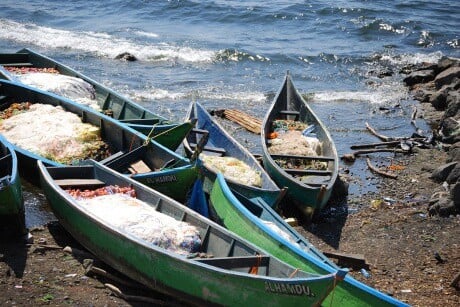For decades, scientists have known that unhealthy surroundings induce human illness. Now, research suggests that communities of very sick people may damage the environment, according to a new study in the Proceedings of the National Academy of Sciences, April 3.
“The environment influences human health, but we know little about how human health affects the environment,” said lead author , a postdoctoral fellow at Cornell’s Atkinson Center for a Sustainable Future. “Millions of people around the world rely on natural resources for food and livelihood – and they often face illnesses that change their physical capacities and outlook, and shapes their influence on the environment.”
She continued: “When poor health accelerates environmental decline, this process can create a downward spiral for ecosystems and the health of the people who depend on them most.”
Over a yearlong period, scientists followed more than 300 households in an HIV/AIDS-affected community around Lake Victoria, Kenya, to see how gradations of illness mold fishing practices. There is a high prevalence of HIV around Lake Victoria – about 27 percent among adults in the villages the scientists studied – with high rates of HIV and other illnesses also a concern throughout global small-scale fishing communities in developing countries.
Only the sickest people did not fish, the scientists found. Sick fishermen who were not bedridden, however, shifted their methods to avoid physically demanding and sustainable methods, opting instead for physically easier, likely illegal and environmentally destructive practices.
Unsustainable harvesting practices are key concerns throughout global fisheries, said Fiorella. To reduce destructive practices, fishing gear and catch regulations are mandated, and around Lake Victoria the fishery is co-managed by local fishermen, national ministries and an international organization.
For Lake Victoria fishermen, long line, gillnet and small seine are legal, regulated, sustainable fishing methods. Use of beach seine (a beach dragnet) and monofilament lines (which when discarded endanger fish and animals) are outlawed but remain widely used, as they allow fishers to target shore areas rather than travel to deeper waters.
Other studies have found that Nile perch – the most abundant fish – declined by 65 percent at near-shore areas and by 30 percent in the lake’s deep zones from 2002-14.
“Globally, 90 percent of fish stock are fished above capacity, and the effective management of these natural resources is critical,” said Fiorella, who explained that managing natural resources in places like Kenya often falls to communities facing high illness rates.
Fiorella and her colleagues suggest addressing the health of people who rely on natural resources to ensure they can manage for environmental sustainability.
“We increasingly recognize the complexity through which the well-being of people and the environment are linked,” said Fiorella. “Given the importance of fisheries to the income and food security of communities around the world, appreciating the role of human health in environmental sustainability can help us to better understand the drivers of resource overharvest.”
In addition to Fiorella, Justin Brashares of the University of California, Berkeley, is senior author on “Human Health Alters the Sustainability of Fishing Practices in East Africa.” The other authors are Erin Milner and Lia Fernald, Berkeley; Charles Salmen, University of Minnesota; Matthew Hickey, University of California, San Francisco; Dan Omollo, Abdi Odhiambo and Brian Mattah, Organic Health Response, Kenya; and Elizabeth Bukusi, Kenya Medical Research Institute.
The National Science Foundation and the Atkinson Center for a Sustainable Future funded this research.


